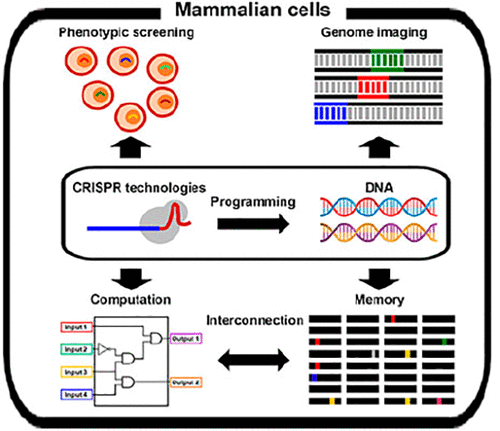当前位置:
X-MOL 学术
›
ACS Synth. Biol.
›
论文详情
Our official English website, www.x-mol.net, welcomes your feedback! (Note: you will need to create a separate account there.)
Advancing CRISPR-Based Programmable Platforms beyond Genome Editing in Mammalian Cells.
ACS Synthetic Biology ( IF 4.7 ) Pub Date : 2019-12-11 , DOI: 10.1021/acssynbio.9b00297 Yasutomi Higashikuni , Timothy K. Lu
ACS Synthetic Biology ( IF 4.7 ) Pub Date : 2019-12-11 , DOI: 10.1021/acssynbio.9b00297 Yasutomi Higashikuni , Timothy K. Lu

|
Human diseases are caused by dysregulation of cellular biological programs that are encoded in DNA. Unveiling the endogenous programs and encoding new programs into the genome are key to creating novel diagnostic and therapeutic strategies. CRISPR/Cas9, originally identified in bacteria, has revolutionized genome editing in mammalian cells. Recent advances in CRISPR technologies have provided new programmable platforms for modifying cell function and behavior. CRISPR-based transcriptional regulators and modified gRNAs have enabled multiplexed regulation and visualization of genome dynamics with spatiotemporal precision. Using these toolkits, genome-scale screening platforms can identify key genetic elements or combinations thereof that modulate phenotypes in mammalian cells. In addition, imaging platforms for multiplexed genomic labeling have been created to study the conformation and dynamics of chromatin in living cells, which are essential for genome function. Furthermore, CRISPR-based computation and memory platforms have been built in living mammalian cells by using DNA as a data processing and storage medium to regulate and monitor cellular behaviors. The conditional regulation of CRISPR-based parts has enabled the design of complex multilayered biological programs. CRISPR-based memory platforms can continuously record biological events as mutations in defined DNA loci. By making use of base editors, CRISPR-based computation and memory platforms have been interconnected to perform logic operations based on past events. These technologies open up new avenues for understanding biological phenomena and designing mammalian cells as living machines for biomedical applications.
中文翻译:

超越哺乳动物细胞中基因组编辑的,基于CRISPR的可编程平台的发展。
人类疾病是由DNA中编码的细胞生物学程序失调引起的。揭示内源程序并将新程序编码到基因组中是创建新的诊断和治疗策略的关键。最初在细菌中鉴定的CRISPR / Cas9彻底改变了哺乳动物细胞中的基因组编辑。CRISPR技术的最新进展为修改细胞功能和行为提供了新的可编程平台。基于CRISPR的转录调节因子和修饰的gRNA已实现时空精度的基因组动力学多重调控和可视化。使用这些工具包,基因组规模的筛选平台可以识别调节哺乳动物细胞表型的关键遗传元件或其组合。此外,已经建立了用于多重基因组标记的成像平台,以研究活细胞中染色质的构象和动力学,这对于基因组功能至关重要。此外,已经通过使用DNA作为数据处理和存储介质来调节和监测细胞行为,在活的哺乳动物细胞中建立了基于CRISPR的计算和存储平台。基于CRISPR的零件的条件调节已使设计复杂的多层生物程序成为可能。基于CRISPR的存储平台可以连续地将生物学事件记录为已定义的DNA基因座中的突变。通过使用基本编辑器,基于CRISPR的计算和内存平台已互连在一起,可以根据过去的事件执行逻辑运算。
更新日期:2019-12-11
中文翻译:

超越哺乳动物细胞中基因组编辑的,基于CRISPR的可编程平台的发展。
人类疾病是由DNA中编码的细胞生物学程序失调引起的。揭示内源程序并将新程序编码到基因组中是创建新的诊断和治疗策略的关键。最初在细菌中鉴定的CRISPR / Cas9彻底改变了哺乳动物细胞中的基因组编辑。CRISPR技术的最新进展为修改细胞功能和行为提供了新的可编程平台。基于CRISPR的转录调节因子和修饰的gRNA已实现时空精度的基因组动力学多重调控和可视化。使用这些工具包,基因组规模的筛选平台可以识别调节哺乳动物细胞表型的关键遗传元件或其组合。此外,已经建立了用于多重基因组标记的成像平台,以研究活细胞中染色质的构象和动力学,这对于基因组功能至关重要。此外,已经通过使用DNA作为数据处理和存储介质来调节和监测细胞行为,在活的哺乳动物细胞中建立了基于CRISPR的计算和存储平台。基于CRISPR的零件的条件调节已使设计复杂的多层生物程序成为可能。基于CRISPR的存储平台可以连续地将生物学事件记录为已定义的DNA基因座中的突变。通过使用基本编辑器,基于CRISPR的计算和内存平台已互连在一起,可以根据过去的事件执行逻辑运算。



























 京公网安备 11010802027423号
京公网安备 11010802027423号